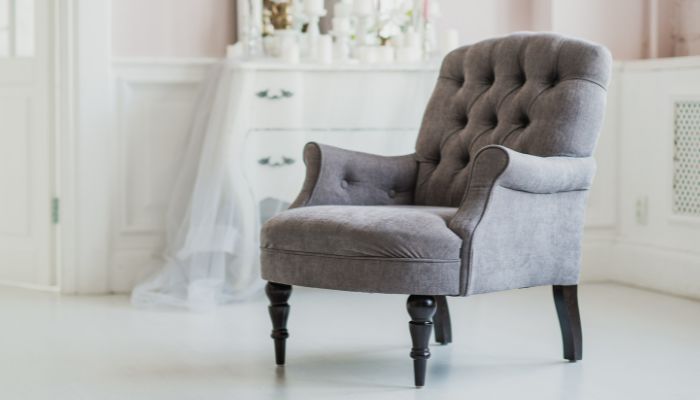Cleaning an Upholstered Chair: The Need-To-Know

Upholstered chairs are one of the most important pieces in every household, and with that comes a great responsibility to keep them clean and prevent damage. In this article we will explain step-by-step how to clean upholstered chair and which mistakes to avoid.
Keep reading to find out the best maintenance practices for upholstered chairs!
How Often Should You Clean Upholstered Chairs?
Maintaining upholstered chairs can be quite a challenge, and many are wondering how often they can clean them without damaging the fabric. The frequency of cleaning upholstered chairs depends on a few factors and how much wear and tear the chair receives.
If you use the upholstered chairs on a daily level, then you should clean them more often. For example, if you spill a drink, you should clean it immediately. Cleaning upholstered chairs once a week is also important to practice if you use the chairs every day and all you need is to vacuum the dust and hairs with the special brush attachment on your vacuum cleaner.
Another great practice to keep your chairs looking good is to clean them with a steam cleaner every season or more often if needed. The advantage of steam cleaners is that they can disinfect your upholstered chairs, removing germs, pests, and allergens.
Here are some general guidelines you should follow to determine the best time to clean the chairs:
Regular Maintenance
It’s best to take care of your chairs based on the environment and how much you use them to prevent dirt and germs from accumulating inside the fabric. Regular maintenance includes vacuuming the chairs with an upholstery brush attachment every few days.
Stains
Spills and stains are the most common problem, especially if you use the chairs all the time. In this case, it’s important to react fast and clean them as soon as you can because most stubborn stains are harder to clean as time passes. If you have extremely stubborn stains, you will need help from professionals.
Pets and Children
Pets and children can give us all the love in this world, but there is a price to pay. Don’t worry; with a proper approach, you can easily clean spills and stains caused by your kids or pets. You just need to clean the upholstered chairs more frequently to maintain a healthy and clean space.
Environmental Factors
The condition of your upholstered chairs mainly depends on the environment in which they are used. For example, if the chairs are placed next to the window or door, the possibility of accumulating dust, dirt, or pollen is much higher. So, keeping your chairs in high-traffic areas will lead to more frequent cleaning.
Recommendations from the Manufacturer
Always read and practice the manufacturer’s recommendations on how to clean an upholstered chair properly and prevent damage. Some fabrics, especially if they are delicate, will require special care, and the given instructions will extend the lifespan of the upholstered chairs.
Ultimately, the best way to decide whether to clean your upholstered chairs is to pay attention to their condition and appearance. Being watchful will help prevent further damage, keep them clean, and increase their lifespan.
How to Clean Upholstered Chair: Step-by-Step
Following these basic cleaning rules and the manufacturer’s instructions will help you protect the fabric and keep a clean upholstered chair for a long time. But first, take a look at all the tools and products you may need:
- Vacuum cleaner with an upholstery brush attachment
- Steam cleaner (optional)
- Spray bottle
- Warm water
- White vinegar
- Mild dish or laundry detergent
- Baking soda
- Soft brush
- Clean microfiber cloths
Step-by-step guide on cleaning upholstered chairs:
Prepare the Area
First, you need to prepare the area around the chair. Move the furniture or any objects around to have a clear workspace that is easy to approach. This will help you prevent accidental damage and have a more manageable space to maneuver better with your tools.
Vacuuming
Every chair is different; depending on its design, dust and dirt collect around the corners, crevices, or seams. To clean it efficiently, use the vacuum cleaner’s upholstery attachment and vacuum it gently .
Vacuum the entire chair surface, including the armchairs and the underside, and don’t forget the edges where the fabric meets the wooden or metal legs of the chairs.
Prepare the Cleaning Solution
Before you clean the chair, you need to determine the type of stains on the upholstery. Usually, mild stains can be removed with a mix of white vinegar and baking soda or with a gentle detergent diluted with water. You will need a specifically formulated product appropriate for the chair’s fabric to remove set-in stains.
Spot Testing
It’s important to make a test on a small, not-so-visible area of the chair before you apply the cleaning solution on the upholstery. Choose a spot on the back or underside of the chair to perform the test by applying a little bit of the cleaning solution on a cloth and gently rubbing it into the spot. Wait for a couple of minutes and see if there are any reactions, such as fabric damage or color bleeding, and continue with the cleaning process.
Stain Removal
After you identify the type of stains and test the cleaning solution, it’s time to clean the entire chair. Use a spray bottle and a clean cloth to dampen the entire area, and gently rub the cleaning solution on the fabric. Also, you can gently scrub the upholstery with a sponge or soft bristle brush.
As the dirt can transfer while you clean the area, rinse the cloth in clear water all the time. Also, don’t rub vigorously; that way, you’ll push the dirt deeper into the upholstery and cause it to spread even more.
Rinse and Dry
After cleaning the upholstery, you need to remove the residue of the cleaning solution. To rinse it properly, spray the area with water and wipe it with a clean cloth. Rinse the cloth as it absorbs the cleaning solution and continue until you no longer see a soapy residue on the upholstery.
After rinsing the soap, make sure you dry the fabric properly. You can use paper towels to dry it as much as possible, leave it under a running ceiling fan, or place it near an open window. Avoid drying upholstered chairs under direct sunlight or using heat dryers directly on them.
Upholstery Protection
It’s not mandatory, but you can apply a fabric protector to a clean upholstered chair to create a protective barrier that can repel stains and spills, making your chairs look cleaner for longer.
Mistakes to Avoid When Cleaning Upholstered Chair
Taking care of upholstered chairs requires attention and knowledge to avoid mistakes that can cause damage to the fabric. Take a look at the following most common mistakes to avoid when cleaning upholstered chairs:
- Not reading the instructions. Every upholstered chair comes with a guide and instructions from the manufacturer to prevent potential damage. Not following these instructions can lead to discoloration of the fabric or damage that can’t be repaired.
- Skipping the spot test. Before applying any cleaning solution, testing it on a small not-so-visible area is essential. Ignoring this advice can cause irreversible damage to the upholstery.
- Using harsh chemicals. Avoid harsh cleaning agents, like bleach and abrasive products, unless it’s explicitly recommended by the manufacturing company. This mistake can lead to severe fabric damage and discoloration.
- Rubbing vigorously. Forget about rubbing or scrubbing the fabric too vigorously. This won’t make the cleaning process faster but only worsens it by pushing the dirt deeper.
- Avoid vacuuming before cleaning. A must-do step in cleaning your upholstered chair is to vacuum the entire surface, so you can prepare the area for the next steps.
- Avoid over-wetting. To help the drying process and prevent shrinkage, you must avoid over-wetting the upholstery. Blotting with a clean and dry towel can help remove the remaining moisture.
- Not drying it properly. After cleaning the chair, let it dry properly. Skipping this can cause musty odors, mold, or fabric damage.
Closing Remarks on Cleaning Chair Upholstery
Cleaning your upholstery chair is not an impossible task. With a proper approach and following our step-by-step guide, you can successfully remove stains and odors from the upholstery. With regular maintenance, your upholstered chairs will remain clean and in good condition, increasing their lifespan.
However, cleaning your upholstered chairs can take a lot of time and sometimes requires even more effort than you can imagine. The best way to clean upholstered chairs is to simply call a professional cleaning service that offers a deeper, thorough cleaning.
FAQs
What’s the best homemade upholstery cleaner?
A great homemade cleaning solution you can use is made of 1/4 cup of vinegar, 3/4 cup of water, and a little bit of dish soap.
Will vinegar in water clean upholstery?
Cleaning with vinegar is a great alternative and suitable for most fabrics. However, read the manufacturer’s instructions before cleaning upholstered chairs with vinegar.
How do you get stains out of fabric chair cushions?
Spray white vinegar on the spot and wait 10 minutes. For tough stains, you can use a mix of vinegar and dish soap to scrub the cushions.
Does baking soda clean fabric chairs?
Baking soda is a natural agent to clean upholstery. It can help remove stains, spills, and foul odors.
Recent Posts
Categories





